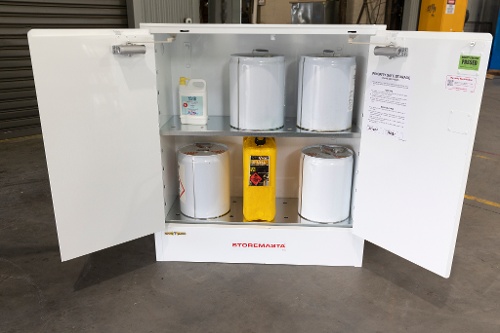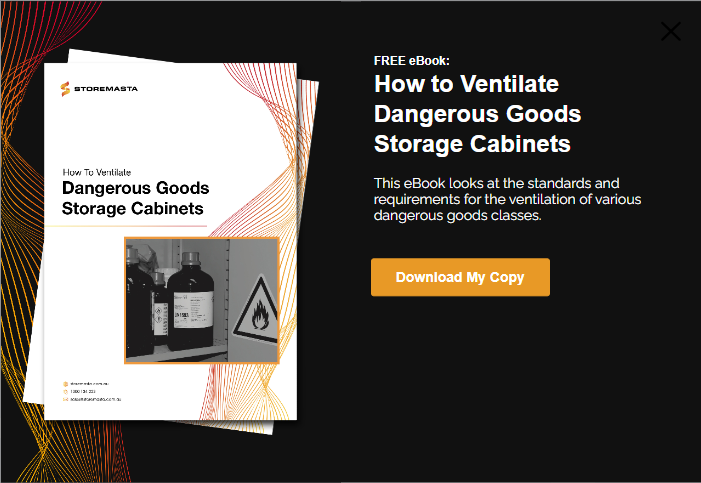If your workplace uses toxic substances on a regular basis, it’s your obligation to ensure that the people and property of your organisation are protected from the risks associated with these substances. One important factor involved in the management of the risks associated with toxic substances is ensuring that they are stored and ventilated in a safe and compliant manner.
Toxic chemicals are substances that will adversely affect your health after entering your body. There are a number of different ways that toxic substances may enter your body. These ways are called the routes of exposure. The three main routes of exposure include ingestion, skin contact and inhalation. Of these three routes of exposure, inhalation is the most common form of exposure to toxic substance.
As inhalation is the most common form of exposure, it’s very important to implement controls in the workplace to reduce your workers exposure to airborne toxic substances. One method that can be used to reduce your workers exposure, is to install ventilation systems on all your toxic substance storage cabinets. When you install a ventilation system on a toxic storage cabinet, it’s important to ensure that it’s installed in such a way that it doesn’t create any further risks upon the people in your workplace. We will now discuss the ventilation requirements for toxic storage cabinets.
Ventilation requirements according to AS/NZS 4452
The Australian Standard that sets out the storage, handling and ventilation requirements for toxic substances is AS/NZS 4452 - The storage and handling of toxic substances. Section 4.4.2.4 of this standard states:
4.4.2.4 Ventilation provisions.
Where mechanical ventilation of the cabinet is required the following requirements apply, in addition to the requirement of clause 6.3.2
- The design of any vent opening in the cabinet wall shall not compromise the structural strength of the cabinet
- The extraction system shall be sufficient to ensure that the ambient concentration of any toxic substances within the breathing zone of any person using the cabinet is maintained as low as practical.
- Where a cabinet incorporates provision for connection to any external venting system:
- (i) The vent opening shall be provided with a means for permanent closure when venting is not required
- (ii) The information supplied with the cabinet shall include instructions on the installation and operation of the vent system; and
- (iii) The cabinet vent designed shall be such as to ensure that surrounding work areas are not contaminated by emissions.
Note: Ventilation provisions should be designed by an appropriately qualified engineer.
As this standard doesn’t state that a ventilation system shall be installed on a toxic , it means that it isn't a mandatory requirement, but it can be done if it’s part of a risk control measure. An instance where you may be legally required to install a ventilation system on your toxic storage cabinets is if the toxic substance that you are storing is listed in the workplace exposure standards. We will now discuss the workplace exposure standards and how they can dictate your need for a ventilation system.
Toxic substances must be stored to meet the requirements of the Australian Standards so spills and vapours can be contained.
Workplace Exposure Standards
Exposure to any kind of hazardous substances will pose significant health risk upon your workers. Some of these health risks include:
- Asphyxiation
- Vomiting
- Nausea
- Headaches
- Irritation to the eyes, ears and throat
- Dizziness
To help combat these health risks, Safework Australia developed the workplace exposure standards. These exposure standards identify around 700 hazardous substances and their legal airborne concentration limits.
If the toxic substances stored inside your toxic storage cabinet are listed in the workplace exposure standards and the concentration of the vapours exceed the limit outlined in this standard, the toxic storage cabinet will require ventilation. The ventilation system will reduce the concentration of airborne toxic substances and decrease the risk of your workers becoming intoxicated. For a ventilation system to successfully reduce the risk of exposure it must be designed and installed in a safe and compliant manner.
Features of a compliant ventilation system for toxic substances
If you conduct a dangerous goods risk assessment and you determine that you require a ventilation system on your toxic storage cabinets, it’s important that you install this ventilation system in such a way that it poses no further risk upon the people in your workplace. A safe and compliant ventilation system for toxic storage cabinets must follow the requirements outlined below:
- A mechanical ventilation system should be designed so that it prevents any vapours from escaping into the room.
- The ventilation system shall be vented to the outside atmosphere in a location that is safe to disperse toxic vapours. A safe location will be away from places where people congregate.
- The air inlet shall be attached to the vent port at the top of the cabinet and the toxic vapours shall be extracted from the bottom vent port via the exhaust fan. This configuration is most effective as most toxic vapours are heavier than air and reside in the bottom of the cabinet.
- A ventilation system cannot be linked to multiple cabinets. A ventilation system connected to multiple cabinets could cause vapours from incompatible dangerous goods to mix, resulting in violent chemical reactions.
- When a mechanical ventilation system is not attached to a cabinet, the vent bungs must be tightly screwed into the vent ports. This stops any toxic vapours from escaping into the workplace.
- In all instances the ventilation system shall not compromise the structural integrity of the cabinet.
- In all cases the ventilation duct shall not be smaller than the size of the venting opening on the side of the cabinet. A ventilation system shall be designed by an appropriately qualified engineer and it shall comply with AS/NZS - 1668.2-2002
Next Steps For Toxic Substance Storage
As toxic vapours can have severe effects upon the health of the people in your organisation, it’s a good practice to ventilate toxic storage cabinets to reduce the concentration of toxic vapours to a safe working limit. A safe ventilation system must follow the requirements outlined above and comply with AS/NZS 4452. For more detailed information on how to ventilate dangerous goods storage cabinets, download of free eBook by clicking on the image below 👇.
Joining the team as a Dangerous Goods Storage Consultant, Melissa Hampton became Storemasta's Marketing Manager in late 2021. With extensive knowledge and experience in chemical compliance, Melissa is responsible for leading the Marketing team and helping shape their marketing strategy. In her spare time, you can find Melissa hiking, swimming and enjoying the great outdoors in beautiful north-west Tasmania.

